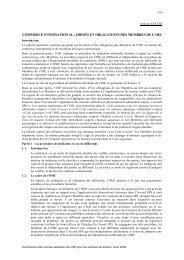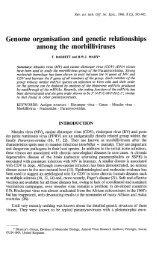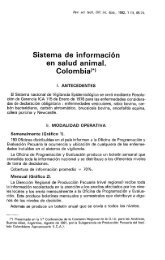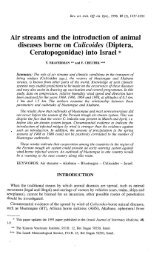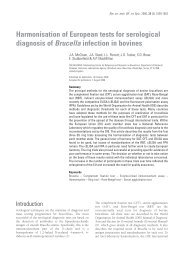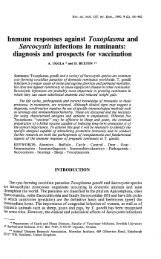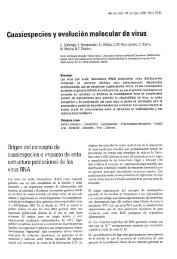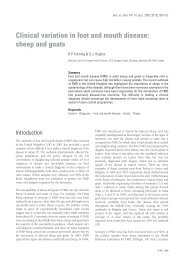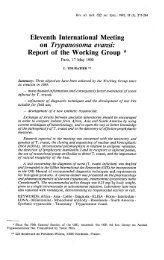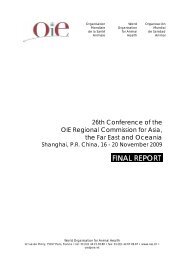GLANDERS - OIE
GLANDERS - OIE
GLANDERS - OIE
Create successful ePaper yourself
Turn your PDF publications into a flip-book with our unique Google optimized e-Paper software.
NB: Version amended following delisting of the mallein test by the World Assembly in May 2012<br />
CHAPTER 2.5.11.<br />
<strong>GLANDERS</strong><br />
SUMMARY<br />
Glanders is a contagious and fatal disease of horses, donkeys, and mules, and is caused by<br />
infection with the bacterium Burkholderia mallei (the name recently changed from Pseudomonas<br />
mallei and was previously classified as Pfeifferella, Loefflerella, Malleomyces or Actinobacillus).<br />
The disease causes nodules and ulcerations in the upper respiratory tract and lungs. A skin form<br />
also occurs, known as ‘farcy’. Control of glanders requires testing of suspect clinical cases,<br />
screening of apparently normal equids, and elimination of positive reactors. It is transmitted to<br />
humans and all infected/contaminated or potentially infected/contaminated material must be<br />
handled in a laboratory that meets the requirements for Containment Group 3 pathogens.<br />
Identification of the agent: Smears from fresh material may reveal Gram-negative nonsporulating,<br />
nonencapsulated rods. The presence of a capsule-like cover has been demonstrated by electron<br />
microscopy. The bacteria grow aerobically and prefer media that contain glycerol. Unlike the<br />
Pseudomonas species and the closely related bacterium Burkholderia pseudomallei, Burkholderia<br />
mallei is nonmotile. Guinea-pigs are highly susceptible, and males can be used, if strictly<br />
necessary, to recover the organism from a heavily contaminated sample. Commercially available<br />
biochemical identification kits lack diagnostic sensitivity. Specific monoclonal antibodies and<br />
polymerase chain reaction (PCR) as well as real-time PCR assays are available. The latter have<br />
also been evaluated in recent outbreaks.<br />
Mallein and serological tests: Complement fixation test and enzyme-linked immunosorbent<br />
assays are the most accurate and reliable serological tests for diagnostic use. The mallein test is a<br />
sensitive and specific clinical test for hypersensitivity against Burkholderia mallei. Mallein, a water<br />
soluble protein fraction of the organism, is injected subcutaneously, intradermo-palpebrally or given<br />
by eyedrop. In infected animals, the skin or the eyelid swells markedly within 1–2 days. A rose<br />
bengal plate agglutination test has recently been developed in Russia; it has been validated in<br />
Russia only.<br />
Requirements for vaccines and diagnostic biologicals: There are no vaccines. Mallein purified<br />
protein derivative is currently available commercially from the Central Veterinary Control and<br />
Research Institute, 06020 Etlik, Ankara, Turkey.<br />
A. INTRODUCTION<br />
Glanders is a bacterial disease of perissodactyls or odd-toed ungulates with zoonotic potential known since<br />
ancient times. It is caused by the bacterium Burkholderia mallei (the name recently changed from Pseudomonas<br />
mallei (Yabuuchi et al., 1992) and has been classified in the past as Pfeifferella, Loefflerella, Malleomyces or<br />
Actinobacillus). Outbreaks of the disease may occur in felines living in the wild or in zoological gardens.<br />
Susceptibility to glanders has been proved in camels, bears, wolfs and dogs. Carnivores may become infected by<br />
eating infected meat, but cattle and pigs are resistant (Minett, 1959). Small ruminants may also be infected if kept<br />
in close contact to glanderous horses (Wittig et al., 2006). Glanders in the acute form occurs most frequently in<br />
donkeys and mules with high fever and respiratory signs (swollen nostrils, dyspnoea, and pneumonia); death<br />
occurs within a few days. In horses, glanders generally takes a more chronic course and they may survive for<br />
several years. Chronic and subclinical ‘occult’ cases are dangerous sources of infection due to permanent or<br />
intermittent shedding of bacteria (Wittig et al., 2006).<br />
In horses, inflammatory nodules and ulcers develop in the nasal passages and give rise to a sticky yellow<br />
discharge, accompanied by enlarged firm submaxillary lymph nodes. Stellate scarring follows upon healing of the<br />
ulcers. The formation of nodular abscesses in the lungs is accompanied by progressive debility, febrile episodes,<br />
<strong>OIE</strong> Terrestrial Manual 2012 1
Chapter 2.5.11. — Glanders<br />
coughing and dyspnoea. Diarrhoea and polyuria can also occur. In the skin form (‘farcy’), the lymphatics are<br />
enlarged and nodular abscesses (‘buds’) of 0.5–2.5 cm develop, which ulcerate and discharge yellow oily pus.<br />
Nodules are regularly found in the liver and spleen. Discharges from the respiratory tract and skin are infective,<br />
and transmission between animals, which is facilitated by close contact, by inhalation, ingestion of contaminated<br />
material (e.g. from infected feed and water troughs), or by inoculation (e.g. via a harness) is common. The<br />
incubation period can range from a few days to many months (Monlux, 1984; Wittig et al., 2006).<br />
Glanders is transmissible to humans by direct contact with diseased animals or infected/contaminated material. In<br />
the untreated acute disease. 95% mortality can occur within 3 weeks (Neubauer et al., 1997). However, survival is<br />
possible if the infected person is treated early and aggressively with multiple systemic antibiotic therapies (Kahn &<br />
Ashford, 2001; Srinivasan et al., 2001). A chronic form with abscessation also occurs (Neubauer et al., 1997).<br />
When handling suspect or known infected animals or fomites, stringent precautions should be taken to prevent<br />
self-infection or transmission of the bacterium to other equids. Laboratory samples should be securely packaged,<br />
kept cool and shipped as outlined in Chapter 1.1.1 Collection and shipment of diagnostic specimens. All<br />
manipulations with potentially infected/contaminated material must be performed in a laboratory that meets the<br />
requirements for Containment Group 3 pathogens as outlined in Chapter 1.1.2 Biosafety and biosecurity in the<br />
veterinary microbiology laboratory and animal facilities.<br />
Glanders has been eradicated from many countries by statutory testing, elimination of infected animals, and<br />
import restrictions. It persists in some Asian, African and South American countries. It can be considered a reemerging<br />
disease and may be imported by pet or racing equids into glanders free areas (Neubauer et al., 2005).<br />
1. Identification of the agent<br />
B. DIAGNOSTIC TECHNIQUES<br />
Cases for specific glanders investigation should be differentiated on clinical grounds from other chronic infections<br />
of the nasal mucosae or sinuses, and from strangles (Streptococcus equi infection), ulcerative lymphangitis<br />
(Corynebacterium pseudotuberculosis), pseudotuberculosis (Yersinia pseudotuberculosis) and sporotrichosis<br />
(Sporotrichium spp.). Glanders should be excluded positively from suspected cases of epizootic lymphangitis<br />
(caused by Histoplasma farciminosum), with which it has many clinical similarities. In humans in particular,<br />
glanders should be distinguished from melioidosis (B. pseudomallei infection), which is caused by an organism<br />
with close similarities to B. mallei (Minett, 1959).<br />
a) Morphology of Burkholderia mallei<br />
The organisms are fairly numerous in smears from fresh lesions, but in older lesions they are scanty (Wilson<br />
& Miles, 1964). They should be stained by methylene blue or Gram stain. The organisms are mainly<br />
extracellular, fairly straight Gram-negative rods with rounded ends, 2–5 µm long and 0.3–0.8 µm wide with<br />
granular inclusions of various size. They often stain irregularly and do not have a readily visible capsule,<br />
under the light microscope, or form spores. The presence of a capsule-like cover has been established by<br />
electron microscopy. This capsule is composed of neutral carbohydrates and serves to protect the cell from<br />
unfavourable environmental factors. Unlike other organisms in the Pseudomonas group and its close relative<br />
Burkholderia pseudomallei, Burkholderia mallei has no flagellae and are therefore nonmotile (Krieg & Holt,<br />
1984; Sprague & Neubauer, 2004). The organisms are difficult to demonstrate in tissue sections, where they<br />
may have a beaded appearance (Miller et al., 1948). In culture media, they vary in appearance depending<br />
on the age of the culture and type of medium. In older cultures, there is much pleomorphism. Branching<br />
filaments form on the surface of broth cultures (Neubauer et al., 2005).<br />
b) Cultural characteristics<br />
It is preferable to attempt isolation from unopened uncontaminated lesions (Miller et al., 1948). The organism<br />
is aerobic and facultatively anaerobic only in the presence of nitrate (Gilardi, 1985; Krieg & Holt, 1984),<br />
growing optimally at 37°C (Mahaderan et al., 1987). It grows well, but slowly, on ordinary culture media, 72hour<br />
incubation of cultures is recommended; glycerol enrichment is particularly useful. After a few days on<br />
glycerol agar, there is a confluent, slightly cream-coloured growth that is smooth, moist, and viscuous. With<br />
continued incubation, the growth thickens and becomes dark brown and tough. It also grows well on glycerol<br />
potato agar and in glycerol broth, on which a slimy pellicle forms. On plain nutrient agar, the growth is much<br />
less luxuriant, and growth is poor on gelatin (Steele, 1980). In samples not obtained under sterile conditions<br />
B. mallei is regularly overgrown by other bacteria.<br />
Alterations to characteristics may occur in vitro, so fresh isolates should be used for identification reactions.<br />
Litmus milk is slightly acidified by B. mallei, and coagulation may occur after long incubation. The organism<br />
reduces nitrates. Although some workers have claimed that glucose is the only carbohydrate that is<br />
fermented (slowly and inconstantly), other workers have shown that if an appropriate medium and indicator<br />
are used, glucose and other carbohydrates, such as arabinose, fructose, galactose and mannose, are<br />
2 <strong>OIE</strong> Terrestrial Manual 2012
Chapter 2.5.11. — Glanders<br />
consistently fermented by B. mallei (Evans, 1966). Indole is not produced, horse blood is not haemolysed<br />
and no diffusible pigments are produced in cultures (Krieg & Holt, 1984). A commercial laboratory test kit<br />
(e.g. API [Analytical Profile Index] system: Analytab Products, BioMerieux or Biolog [Hayward, California])<br />
can be used for easy confirmation that an organism belongs to the Pseudomonas group. In general,<br />
commercially available systems are not suited to unambiguously identifying members of the steadily growing<br />
number of species of the genus Burkholderia (Glass & Popovic, 2005). Lack of motility is then of special<br />
relevance. A bacteriophage specific for B. mallei is available (Woods et al., 2002).<br />
All culture media prepared should be subjected to quality control and must support growth of the suspect<br />
organism from a small inoculum. The reference strain should be cultured in parallel with the suspicious<br />
samples to ensure that the tests are working correctly.<br />
In contaminated samples, supplementation of media with substances that inhibit the growth of Gram-positive<br />
organisms (e.g. crystal violet, proflavine) has proven to be of use, as has pretreatment with penicillin<br />
(1000 units/ml for 3 hours at 37°C) (Minett, 1959). A selective medium has been developed (Xie et al., 1980)<br />
composed of polymyxin E (1000 units), bacitracin (250 units), and actidione (0.25 mg) incorporated into<br />
nutrient agar (100 ml) containing glycerine (4%), donkey or horse serum (10%), and ovine haemoglobin or<br />
tryptone agar (0.1%).<br />
Outside the body, the organism has little resistance to drying, heat, light or chemicals, so that survival<br />
beyond 2 weeks is unlikely (Neubauer et al., 1997). Under favourable conditions, however, it can probably<br />
survive a few months. Burkholderia mallei can remain viable in tap water for at least 1 month (Steele, 1980).<br />
For disinfection, benzalkonium chloride or ‘roccal’ (1/2,000), sodium hypochlorite (500 ppm available<br />
chlorine), iodine, mercuric chloride in alcohol, and potassium permanganate have been shown to be highly<br />
effective against B. mallei (Mahaderan et al., 1987). Phenolic disinfectants are less effective.<br />
c) Laboratory animal inoculation<br />
Guinea-pigs, hamsters and cats have been used for diagnosis when necessary. If isolation in a laboratory<br />
animal is considered unavoidable, suspected material is inoculated intraperitoneally into a male guinea-pig.<br />
As this technique has a sensitivity of only 20%, the inoculation of at least five animals is recommended<br />
(Neubauer et al., 1997). Positive material will cause a severe localised peritonitis and orchitis (the Strauss<br />
reaction). The number of organisms and their virulence determines the severity of the lesions. Additional<br />
steps are used when the test material is heavily contaminated (Gould, 1950). The Strauss reaction is not<br />
specific for glanders, and other organisms can elicit it. Bacteriological examination of infected testes should<br />
confirm the specificity of the response obtained.<br />
d) Confirmation by polymerase chain reaction and real-time PCR<br />
In the past few years, several PCR and real-time PCR assays for the identification of Burkholderia mallei<br />
have been developed (Bauernfeind et al., 1998; Lee et al., 2005; Sprague et al., 2002; Thibault et al., 2004;<br />
Ulrich et al., 2006; U’Ren et al., 2005), but only a PCR and a real-time PCR assay were evaluated using<br />
samples from a recent outbreak of glanders in horses (Scholz et al., 2006; Tomaso et al., 2006). These two<br />
assays will be described in more detail here. However, the robustness of these assays will have to be<br />
demonstrated in the future by interlaboratory studies. The guidelines and precautions outlined in Chapter<br />
1.1.5 Validation and quality control of polymerase chain reaction methods used for the diagnosis of<br />
infectious diseases, have to be taken into account.<br />
• DNA preparation<br />
Single colonies are transferred from an agar plate to 200 µl lysis buffer (5× buffer D [PCR Optimation Kit,<br />
Invitrogen, DeShelp, The Netherlands, 1/5 diluted in ultra-pure water]; 0.5% Tween 20 [ICI, American<br />
Limited, Merck, Hohenbrunn, Germany]; 2 mg/ml proteinase K [Roche Diagnostics, Mannheim, Germany]).<br />
After incubation at 56°C for 1 hour and inactivation for 10 minutes at 95°C, 2 and 4 µl of the cleared lysate<br />
are used as template in the PCR or the real-time PCR assay, respectively.<br />
Tissue samples of horses (skin, liver, spleen, lung, and conchae) inactivated and preserved in formalin<br />
(48 hours, 10% v/v) are cut with a scalpel into pieces of 0.5 × 0.5 cm (approximately 500 mg). The<br />
specimens are washed twice in deionised water (10 ml), incubated over night in sterile saline at 4°C, and<br />
minced using liquid nitrogen, a mortar and a pestle. Total DNA is prepared from 50 mg tissue using the<br />
QIAamp Tissue Kit TM according to the manufacturer’s instructions (Qiagen, Hilden, Germany). DNA is eluted<br />
with 80 µl dH 2 O of which 4 µl are used as template.<br />
• PCR assay (Scholz et al., 2006)<br />
The assay may have to be adapted to the PCR instrument used with minor modifications to the cycle<br />
conditions and the concentration of the chemicals used.<br />
<strong>OIE</strong> Terrestrial Manual 2012 3
Chapter 2.5.11. — Glanders<br />
The oligonucleotides used in by Scholz et al. (2006) are designed based on differences of the fliP<br />
sequences from B. mallei ATCC 23344 T (accession numbers NC_006350, NC_006351) and B. pseudomallei<br />
K96243 (accession numbers NC_006348, NC_006349). Primers Bma-IS407-flip-f (5’-TCA-GGT-TTG-<br />
TAT-GTC-GCT-CGG-3’) and Bma- IS407-flip-r (5’-CTA-GGT-GAA-GCT-CTG-CGC-GAG-3’) are used to<br />
amplify a 989 bp fragment. PCR is done using 50 µl ready-to-go mastermix (Eppendorf, Hamburg,<br />
Germany) and 15 pmol of each primer. Thermal cycling conditions are 94°C for 30 seconds; 65°C for<br />
30 seconds and 72°C for 60 seconds. This cycle is repeated for 35 times. A final elongation step is added<br />
(72°C for 7 minutes). Visualisation of the products is done by UV light after agarose gel (1% w/v in TAE<br />
buffer) electrophoresis and staining with ethidium bromide. No template controls containing PCR-grade<br />
water instead of template and positive controls containing DNA of B. mallei have to be included in each run<br />
to detect contamination by amplicons of former runs or amplification failure.<br />
The lower detection limit is 10 fg or 2 genome equivalents.<br />
• Real-time PCR assay (Tomaso et al., 2006)<br />
The assay has to be adapted to the real-time PCR instrument used with minor modifications, e.g. the cycling<br />
vials have to be chosen according to the manufacturer’s recommendations and the concentration of the<br />
oligonucleotides may have to be doubled or the labelling of the probes has to be changed. The authors used<br />
a MX3000P TM real-time PCR system (Stratagene, Amsterdam, The Netherlands) and 96-well plates<br />
(ThermoFast 96 ABGene TM , Rapidozym, Berlin, Germany).<br />
The oligonucleotides used by Tomaso et al. (2006) were designed based on differences of the fliP<br />
sequences from B. mallei ATCC 23344 T (accession numbers NC_006350, NC_006351) and B. pseudomallei<br />
K96243 (accession numbers NC_006348, NC_006349). The fluorogenic probe is synthesised with 6carboxy-fluorescein<br />
(FAM) at the 5’-end and black hole quencher 1 (BHQ1) at the 3’-end. Oligonucleotides<br />
used were Bma-flip-f (5’-CCC-ATT-GGC-CCT-ATC-GAA-G-3’), Bma-flip-r (5’-GCC-CGA-CGA-GCA-CCT-<br />
GAT-T-3’) and probe Bma-flip (5’-6FAM-CAG-GTC-AAC-GAG-CTT-CAC-GCG-GAT-C-BHQ1-3’).<br />
The 25 µl reaction mixture consists of 12.5 µl 2× TaqMan TM Universal MasterMix (Applied Biosystems,<br />
Foster City, USA), 0.1 µl of each primer (10 pmol/µl), 0.1 µl of the probe (10 pmol/µl) and 4 µl sample.<br />
Thermal cycling conditions are 50°C for 2 minutes; 95°C for 10 minutes; 45 (50) cycles at 95°C for<br />
25 seconds and 63°C for 1 minute. Possible contaminations with amplification products from former<br />
reactions are inactivated by an initial incubation step using uracil N’-glycosilase.<br />
The authors suggest to include an internal inhibition control based on a bacteriophage lambda gene target<br />
(Lambda-F [5’-ATG-CCA-CGT-AAG-CGA-AAC-A-3] Lambda-R [5’-GCA-TAA-ACG-AAG-CAG-TCG-AGT-3’],<br />
Lam-YAK [5’-YAK-ACC-TTA-CCG-AAA-TCG-GTA-CGG-ATA-CCG-C-DB-3’]), which can be titrated to give<br />
reproducible cycle threshold values. However, depending on the sample material a house keeping gene<br />
targeting PCR may be used additionally or as an alternative. No template controls containing 4 µl of PCRgrade<br />
water instead and positive controls containing DNA of B. mallei have to be included in each run to<br />
detect amplicon contamination or amplification failure.<br />
The linear range of the assay was determined to cover concentrations from 240 pg to 70 fg bacterial<br />
DNA/reaction. The lower limit of detection defined as the lowest amount of DNA that was consistently<br />
detectable in three runs with eight measurements each is 60 fg DNA or four genome equivalents (95%<br />
probability). The intra-assay variability of the fliP PCR assay for 35 pg DNA/reaction is 0.68 % (based on Ct<br />
values) and for 875 fg 1.34%, respectively. The inter-assay variability for 35 pg DNA/reaction is 0.89%<br />
(based on Ct values) and for 875 fg DNA 2.76 %, respectively.<br />
e) Other methods<br />
The genome of the Burkholderia mallei type strain ATCC 23344 T was sequenced in 2004 (Nierman et al.,<br />
2004). Several genomes of other isolates followed and revealed a wide genomic plasticity. Passages in<br />
different host species or culture media may provoke considerable sequence alterations (Romero et al.,<br />
2006). The loss of the ability to produce LPS and/or capsule polysaccharide upon ongoing culture due to<br />
mutation is a well known fact and results in reduced or absent virulence and influences serologic tests<br />
(Neubauer et al., 2005). Several molecular typing techniques have successfully been introduced. Simple<br />
molecular techniques like PCR-restriction fragment length polymorphism (Tanpiboonsak et al., 2004) and<br />
pulsed field gel electrophoresis (Chantratita et al., 2006) can be used for further discrimination of isolates.<br />
Ribotyping using restriction enzymes PstI and EcoRI in combination with an E. coli 18-mer rDNA probe<br />
produced 17 distinct ribotypes within 25 B. mallei isolates (Harvey & Minter, 2005). These techniques are<br />
still the in-house tests of specialised laboratories as an extensive strain collection is necessary. Multilocus<br />
sequence typing (MLST) can be done with purified DNA so there is no need for excessive cultivation of the<br />
agent or the keeping of strain collections. Web-based analysis might even enhance diagnostics (Godoy et<br />
4 <strong>OIE</strong> Terrestrial Manual 2012
Chapter 2.5.11. — Glanders<br />
al., 2003). No specific histopathology features can be described for lesions caused by B. mallei. For<br />
immunuhistochemical analysis, B. mallei specific hyperimmune sera of rabbits can be used.<br />
2. Serological tests and the mallein test<br />
a) Complement fixation test (a prescribed test for international trade)<br />
Although not as sensitive as the mallein test, the CF test is an accurate serological test that has been used<br />
for glanders diagnosis for many years (Blood & Radostits, 1989). It is reported to be 90–95% accurate,<br />
serum being positive within 1 week of infection and remaining positive in the case of exacerbation of the<br />
chronic process (Steele, 1980). Recently, however, the specificity of CF testing has been questioned<br />
(Neubauer et al., 2005).<br />
• Antigen preparation (Kelser & Reynolds, 1935)<br />
i) Flasks of beef infusion broth with 3% glycerol are inoculated with log-phase growth B. mallei and<br />
incubated at 37°C for 8–12 weeks.<br />
ii) The cultures are inactivated by exposing the flasks to flowing steam (100°C) for 60 minutes.<br />
iii) The clear supernatant is decanted and filtered. The filtrate is heated again by exposure to live steam<br />
for 75 minutes on 3 consecutive days, and clarified by centrifugation.<br />
iv) The clarified product is concentrated to one-tenth the original volume by evaporation on a steam or hot<br />
water bath.<br />
v) Concentrated antigen is bottled in brown-glass bottles to protect from light and stored at 4°C. Antigen<br />
has been shown to be stable for at least 10 years in this concentrated state.<br />
vi) Lots of antigen are prepared by diluting the concentrated antigen 1/20 with sterile physiological saline<br />
with 0.5% phenol. The diluted antigen is dispensed into brown-glass vials and store at 4°C. The final<br />
working dilution is determined by a block titration. The final working dilution for CF test use is made at<br />
the time the CF test is performed.<br />
The resulting antigen is primarily lipopolysaccharide. An alternative procedure is to use young cultures by<br />
growing the organism on glycerol–agar slopes for 12 hours and washing off with normal saline. A<br />
suspension of the culture is heated for 1 hour at 70°C and the heat-treated bacterial suspension is used as<br />
antigen. The disadvantage of this antigen preparation method is that the antigen contains all the bacterial<br />
cell components. The antigen should be safety tested by inoculating blood agar plates.<br />
• Test procedure (NVSL, 2006)<br />
i) Serum is diluted 1/5 in veronal (barbiturate) buffered saline containing 0.1% gelatin (VBSG) or CFD<br />
(complement fixation diluent – available as tablets) without gelatine.<br />
ii) Diluted serum is inactivated for 30 minutes at 56°C. The USDA complement fixation protocol calls for<br />
inactivation for 35 minutes (NVSL, 2006). (Serum of equidae other than horses should be inactivated at<br />
63°C for 30 minutes.)<br />
iii) Twofold dilutions of the sera are prepared in 96-well round-bottom microtitre plates.<br />
iv) Guinea-pig complement is diluted in the chosen buffer and 5 (or optionally 4) complement haemolytic<br />
units-50% (CH50 ) are used.<br />
v) Sera, complement and antigen are reacted in the plates and incubated for 1 hour at 37°C. (An alternate<br />
acceptable procedure is overnight incubation at 4°C.)<br />
vi) A 2% suspension of sensitised washed sheep red blood cells is added. The USDA protocol calls for<br />
confirmation of positive reactions in a tube test using 3% sheep red blood cells (NVSL, 2006).<br />
vii) Plates are incubated for 45 minutes at 37°C, and then centrifuged for 5 minutes at 600 g.<br />
A sample that produces 100% haemolysis at the 1/5 dilution is negative, 25–75% haemolysis is suspicious,<br />
and no haemolysis (100% fixation) is positive. Unfortunately, false-positive results can occur, and<br />
B. pseudomallei and B. mallei cross react and cannot be differentiated by serology (Blood & Radostits, 1989;<br />
Neubauer et al., 1997). Also healthy horses can have a false positive CF reaction for a variable period<br />
following a mallein intradermal test.<br />
b) Enzyme-linked immunosorbent assays<br />
Both plate and membrane (blot) enzyme-linked immunosorbent assays (ELISAs) have been reported for the<br />
serodiagnosis of glanders, but none of these procedures has been shown to differentiate serologically<br />
between B. mallei and B. pseudomallei. Blotting approaches have involved both dipstick dot-blot and<br />
<strong>OIE</strong> Terrestrial Manual 2012 5
Chapter 2.5.11. — Glanders<br />
electrophoretically separated and transferred western blot methods (Katz et al., 1999; Verma et al., 1990). A<br />
competitive ELISA that uses an uncharacterised anti-lipopolysaccharide monoclonal antibody has also been<br />
developed and found to be similar to the CF test in performance (Katz et al., 2000). Continuing development<br />
of monoclonal antibody reagents specific for B. mallei antigenic components offers the potential for more<br />
specific ELISAs in the foreseeable future that will help resolve questionable test results of quarantined<br />
imported horses (Burtnick et al., 2002; Feng et al., 2006; Khrapova et al., 1995; Neubauer et al., 1997). At<br />
this time, none of these tests has been validated.<br />
c) The mallein test<br />
The mallein purified protein derivative (PPD), which is available commercially, is a solution of water-soluble<br />
protein fractions of heat-treated B. mallei. The test depends on infected horses being hypersensitive to<br />
mallein. Advanced clinical cases in horses and acute cases in donkeys and mules may give inconclusive<br />
results requiring additional methods of diagnosis to be employed (Allen, 1929).<br />
• The intradermo-palpebral test<br />
This is the most sensitive, reliable and specific test for detecting infected perissodactyls or odd-toed<br />
ungulates, and has largely displaced the ophthalmic and subcutaneous tests (Blood & Radostits, 1989):<br />
0.1 ml of concentrated mallein PPD is injected intradermally into the lower eyelid and the test is read at<br />
24 and 48 hours. A positive reaction is characterised by marked oedematous swelling of the eyelid, and<br />
there may be a purulent discharge from the inner canthus or conjunctiva. This is usually accompanied by a<br />
rise in temperature. With a negative response, there is usually no reaction or only a little swelling of the<br />
lower lid.<br />
d) Other serological tests<br />
The avidin–biotin dot ELISA has been described (Verma et al., 1990), but has not yet been widely used or<br />
validated. The antigen is heat-inactivated bacterial culture that has been concentrated and purified. A dot of<br />
this antigen is placed on a nitrocellulose dipstick that is then used to test for antibody against B. mallei in<br />
equine serum. Using antigen-dotted, preblocked dipsticks, the test can be completed in approximately<br />
1 hour. Serum or whole blood can be used for the test, and partial haemolysis does not impart any<br />
background colour to the antigen-coated area on the nitrocellulose. Recently, polysaccharide microarray<br />
technology has offered a new promising approach to improve sensitivity in serology (Parthasarathy et al.,<br />
2006).<br />
The rose bengal plate agglutination test (RBT) has been described for the diagnosis of glanders in horses<br />
and other susceptible animals; this test has been validated in Russia only. The antigen is a heat-inactivated<br />
bacterial suspension coloured with rose bengal, which is used in a plate agglutination test.<br />
The accuracy of other agglutination tests and precipitin is unsatisfactory for use in control programmes.<br />
Horses with chronic glanders and those in a debilitated condition give negative or inconclusive results.<br />
C. REQUIREMENTS FOR VACCINES AND DIAGNOSTIC BIOLOGICALS<br />
No vaccines are available.<br />
Mallein PPD for use in performing the intradermo-palpebral and ophthalmic tests is produced commercially by the<br />
Central Veterinary Control and Research Institute, 06020 Etlik, Ankara, Turkey.<br />
The ID-Lelystad has provided the following information on requirements for mallein PPD.<br />
1. Seed management<br />
Three strains of Burkholderia mallei are employed in the production of mallein PPD, namely Bogor strain<br />
(originating from Indonesia), Mukteswar strain (India) and Zagreb strain (Yugoslavia). The seed material is kept<br />
as a stock of freeze-dried cultures. The strains are subcultured on to glycerol agar at 37°C for 1–2 days. For<br />
maintaining virulence and antigenicity, the strains may be passaged through guinea-pigs.<br />
2. Method of manufacture<br />
Dorset�Henley medium, enriched by the addition of trace elements, is used for production of mallein PPD. The<br />
liquid medium is inoculated with a thick saline suspension of B. mallei, grown on glycerol agar. The production<br />
medium is incubated at 37°C for about 10 weeks. The bacteria are then killed by steaming for 3 hours in a Koch’s<br />
6 <strong>OIE</strong> Terrestrial Manual 2012
Chapter 2.5.11. — Glanders<br />
steriliser. The fluid is then passed through a layer of cotton wool to remove coarse bacterial clumps. The resulting<br />
turbid fluid is cleared by membrane filtration, and one part trichloroacetic acid 40% is immediately added to nine<br />
parts culture filtrate. The mixture is allowed to stand overnight and a light brownish to greyish precipitate settles.<br />
The supernatant fluid is pipetted off and discarded. The precipitate is centrifuged for 15 minutes at 2500 g and the<br />
layer of precipitate is washed three or more times in a solution of 5% NaCl, pH 3, until the pH is 2.7. The washed<br />
precipitate is dissolved by stirring with a minimum of an alkaline solvent. The fluid is dark brown and a pH of 6.7<br />
will be obtained. This mallein concentrate has to be centrifuged thoroughly and the supernatant is diluted with an<br />
equal amount of a glucose buffer solution. The protein content of this product is estimated by the Kjeldahl method<br />
and freeze-dried after it has been dispensed into ampoules.<br />
3. In-process control<br />
During the period of incubation, the flasks are inspected frequently for any signs of contamination, and suspect<br />
flasks are discarded. A typical growth of the B. mallei cultures comprises turbidity, sedimentation, some surface<br />
growth with a tendency towards sinking, and the formation of a conspicuous slightly orange-coloured ring along<br />
the margin of the surface of the medium.<br />
4. Batch control<br />
Each batch of mallein PPD is tested for sterility, safety, preservatives, protein content and potency.<br />
Sterility testing is performed according to the European Pharmacopoeia guidelines.<br />
The examination for safety is conducted on from five to ten normal healthy horses by carrying out the intradermopalpebral<br />
test. The resulting swelling should be, at most, barely detectable and transient, without any signs of<br />
conjunctival discharge.<br />
Preparations containing phenol as a preservative should not contain more than 0.5% (w/v) phenol. The protein<br />
content should be not less than 0.95 mg/ml and not more than 1.05 mg/ml.<br />
Potency testing is performed in guinea-pigs and horses. The animals are sensitised by subcutaneous inoculation<br />
with a concentrated suspension of heat-killed B. mallei in paraffin oil or incomplete Freund’s adjuvant. Cattle can<br />
also be used instead of horses. The production batch is bioassayed against a standard mallein PPD by<br />
intradermal injection in 0.1 ml doses in such a way that complete randomisation is obtained.<br />
In guinea-pigs, the different areas of erythema are measured after 24 hours, and in horses the increase in skin<br />
thickness is measured by calipers. The results are statistically evaluated, using standard statistical methods for<br />
parallel-line assays.<br />
REFERENCES<br />
ALLEN H. (1929). The diagnosis of glanders. J. R. Army Vet. Corps, 1, 241–245.<br />
BAUERNFEIND A., ROLLER C., MEYER D., JUNGWIRTH R. & SCHNEIDER I. (1998). Molecular procedure for rapid<br />
detection of Burkholderia mallei and Burkholderia pseudomallei. J. Clin. Microbiol., 36, 2737–2741.<br />
BLOOD D.C. & RADOSTITS O.M. (1989). Diseases caused by bacteria. In: Veterinary Medicine, Seventh Edition.<br />
Balliere Tindall, London, UK, 733–735.<br />
BURTNICK M.N., BRETT P.J. & WOODS D.E. (2002). Molecular and physical characterization of Burkholderia mallei O<br />
antigens. J. Bacteriol., 184, 849–852.<br />
CHANTRATITA N., VESARATCHAVEST M., WUTHIEKANUN V., TIYAWISUTSRI R., ULZIITOGTOKH T., AKCAY E., DAY N.P. &<br />
PEACOCK S.J. (2006). Pulsed-field gel electrophoresis as a discriminatory typing technique for the biothreat agent<br />
Burkholderia mallei. Am. J. Trop. Med. Hyg., 74, 345–347.<br />
EVANS D. (1966). Utilization of carbohydrates by Actinobacillus mallei. Can. J. Microbiol., 12, 625–639.<br />
FENG S.H., TSAI S., RODRIGUEZ J., NEWSOME T., EMANUEL P. & LO S.C. (2006). Development of mouse hybridomas<br />
for production of monoclonal antibodies specific to Burkholderia mallei and Burkholderia pseudomallei. Hybridoma<br />
(Larchmt), 25, 193–201.<br />
<strong>OIE</strong> Terrestrial Manual 2012 7
Chapter 2.5.11. — Glanders<br />
GILARDI G.L. (1985). Pseudomonas. In: Manual of Clinical Microbiology, Fourth Edition, Lenette E.H., Bulawo A.,<br />
Hausler W.J. & Shadomy H.J., eds. American Society for Microbiology, Washington DC, USA, 350–372.<br />
GLASS M.B. & POPOVIC T. (2005). Preliminary evaluation of the API 20NE and RapID NF plus systems for rapid<br />
identification of Burkholderia pseudomallei and B. mallei. J. Clin. Microbiol., 43, 479–483.<br />
GODOY D., RANDLE G., SIMPSON A.J., AANENSEN D.M., PITT T.L., KINOSHITA R. & SPRATT B.G. (2003). Multilocus<br />
sequence typing and evolutionary relationships among the causative agents of melioidosis and glanders,<br />
Burkholderia pseudomallei and Burkholderia mallei. J. Clin. Microbiol., 41, 2068–2079.<br />
GOULD J.C. (1950). Mackie and McCartney’s Handbook of Bacteriology, Eighth Edition, Cruickshank R., ed. E. &<br />
S. Livingstone, Edinburgh, UK, 391–394.<br />
HARVEY S.P. & MINTER J.M. (2005). Ribotyping of Burkholderia mallei isolates. FEMS Immunol. Med. Microbiol.,<br />
44, 91–97.<br />
LEE M.A., WANG D. & YAP E.H. (2005). Detection and differentiation of Burkholderia pseudomallei, Burkholderia<br />
mallei and Burkholderia thailandensis by multiplex PCR. FEMS Immunol. Med. Microbiol., 43, 413–417.<br />
KATZ J.B., CHIEVES., HENNAGER S.G., NICHOLSON J.M., FISHER T.A. & BYERS P.E. (1999). Serodiagnosis of equine<br />
piroplasmosis, dourine and glanders using an arrayed immunoblotting method. J. Vet. Diagn. Invest., 11, 292–<br />
294.<br />
KATZ J., DEWALD R. & NICHOLSON J. (2000). Procedurally similar competitive immunoassay systems for the<br />
serodiagnosis of Babesia equi, Babesia caballi, Trypanosoma equiperdum, and Burkholderia mallei infection in<br />
horses. J. Vet. Diagn. Invest., 12, 46–50.<br />
KELSER R.A. & REYNOLDS F.H.K. (1935). Special veterinary laboratory methods, complement fixation test for<br />
glanders. In: Laboratory Methods for the United States Army, Simons J.S. & Gantzkow C.J., eds. Lea and<br />
Febiger, Philadelphia, USA, 973–987.<br />
KHAN A.S. & ASHFORD D.A. (2001). Ready or not – Preparedness for bioterrorism. New Engl. J. Med., 345, 287–<br />
289.<br />
KHRAPOVA N.P., TIKHONOV N.G., PROKHVATILOVA E.V. & KULAKOV M.I. (1995). The outlook for improving the<br />
immunoglobulin preparations for the detection and identification of the causative agents of glanders and<br />
melioidosis. Med. Parazitol., 4, 49–53.<br />
KRIEG N.R. & HOLT J.G., EDS (1984). Gram-negative aerobic rods and cocci. In: Bergey’s Manual of Systematic<br />
Bacteriology Vol. 1. Williams & Wilkins, Baltimore, USA & London, UK, 174–175.<br />
MAHADERAN S., DRAVIDAMANI S. & DARE B.J. (1987). Glanders in horses. Centaurus, III, 135–138.<br />
MILLER W., PANNEL L., CRAVITZ L., TANNER A. & INGALLS M. (1948). Studies on certain biological characteristics of<br />
Malleomyces mallei and Malleomyces pseudomallei I. Morphology, cultivation, viability, and isolation from<br />
contaminated specimens. J. Bacteriol., 55, 115–126.<br />
MINETT F.C. (1959). Glanders (and melioidosis). In: Infectious Diseases of Animals. Vol. 1. Diseases due to<br />
Bacteria, Stableforth A.W. & Galloway I.A., eds. Butterworths Scientific Publications, London, UK, 296–309.<br />
MONLUX W.S. (1984). Diseases affecting food and working animals. In: Foreign Animal Diseases. United States<br />
Department of Agriculture, US Government Printing Office, Washington DC, USA, 178–185.<br />
NATIONAL VETERINARY SERVICES LABORATORIES (2006). Complement Fixation Test for Detection of Antibodies to<br />
Burkholderia mallei – Microtitration Test. United States Department of Agriculture, Animal and Plant Health<br />
Inspection Service, National Veterinary Services Laboratories, Ames, Iowa, USA.<br />
NEUBAUER H., FINKE E.-J. & MEYER H. (1997). Human glanders. International Review of the Armed Forces Medical<br />
Services, LXX, 10/11/12, 258–265.<br />
NEUBAUER H., SPRAGUE L.D., ZACHARIA R., TOMASO H., AL DAHOUK S., WERNERY R., WERNERY U. & SCHOLZ H.C.<br />
(2005). Serodiagnosis of Burkholderia mallei infections in horses: state-of-the-art and perspectives. J. Vet. Med. B<br />
Infect. Dis. Vet. Public Health., 52, 201–205.<br />
8 <strong>OIE</strong> Terrestrial Manual 2012
Chapter 2.5.11. — Glanders<br />
NIERMAN W.C., DESHAZER D., KIM H.S., TETTELIN H., NELSON K.E., FELDBLYUM T., ULRICH R.L., RONNING C.M.,<br />
BRINKAC L.M., DAUGHERTY S.C., DAVIDSEN T.D., DEBOY R.T., DIMITROV G., DODSON R.J., DURKIN A.S., GWINN M.L.,<br />
HAFT D.H., KHOURI H., KOLONAY J.F., MADUPU R., MOHAMMOUD Y., NELSON W.C., RADUNE D., ROMERO C.M., SARRIA<br />
S., SELENGUT J., SHAMBLIN C., SULLIVAN S.A., WHITE O., YU Y., ZAFAR N., ZHOU L. & FRASER C.M. (2004). Structural<br />
flexibility in the Burkholderia mallei genome. Proc. Natl. Acad. Sci. USA., 101, 14246–14251.<br />
PARTHASARATHY N., DESHAZER D., ENGLAND M. & WAAG D.M. (2006). Polysaccharide microarray technology for the<br />
detection of Burkholderia pseudomallei and Burkholderia mallei antibodies. Diagn. Microbiol. Infect. Dis., 56, 329–<br />
332.<br />
ROMERO C.M., DESHAZER D., FELDBLYUM T., RAVEL J., WOODS D., KIM H.S., YU Y., RONNING C.M. & NIERMAN W.C.<br />
(2006). Genome sequence alterations detected upon passage of Burkholderia mallei ATCC 23344 in culture and<br />
in mammalian hosts. BMC Genomics, 5;7, 228.<br />
SCHOLZ H.C., JOSEPH M., TOMASO H., AL DAHOUK S., WITTE A., KINNE J., HAGEN R.M., WERNERY R., WERNERY U. &<br />
NEUBAUER H. (2006). Detection of the reemerging agent Burkholderia mallei in a recent outbreak of glanders in the<br />
United Arab Emirates by a newly developed fliP-based polymerase chain reaction assay. Diagn. Microbiol. Infect.<br />
Dis., 54, 241–247.<br />
SPRAGUE L.D. & NEUBAUER H. (2004). A review on animal melioidosis with special respect to epizootiologie, clinical<br />
presentation and diagnostics. J. Vet. Med. B Infect. Dis. Vet. Public Health, 51, 305–320.<br />
SPRAGUE L.D., ZYSK G., HAGEN R.M., MEYER H., ELLIS J., ANUNTAGOOL N., GAUTHIER Y. & NEUBAUER H. (2002). A<br />
possible pitfall in the identification of Burkholderia mallei using molecular identification systems based on the<br />
sequence of the flagellin fliC gene. FEMS Immunol. Med. Microbiol., 34, 231–236.<br />
SRINIVASAN A., KRAUS C.N., DESHAZER D., BECKER P.M., DICK J.D., SPACEK L., BARTLETT J.G., BYRNE W.R. & THOMAS<br />
D.L. (2001). Glanders in a military research microbiologist. New Engl. J. Med., 345, 256–258.<br />
STEELE J.H. (1980). Bacterial, rickettsial and mycotic diseases. In: CRC Handbook Series in Zoonoses, Section A,<br />
Vol. I, Steele J.H., ed. CRC Press, Boca Raton, USA, 339–351.<br />
TANPIBOONSAK S., PAEMANEE A., BUNYARATAPHAN S. & TUNGPRADABKUL S. (2004). PCR-RFLP based differentiation<br />
of Burkholderia mallei and Burkholderia pseudomallei. Mol. Cell. Probes., 18, 97–101.<br />
THIBAULT F.M., VALADE E. & VIDAL D.R. (2004). Identification and discrimination of Burkholderia pseudomallei, B.<br />
mallei, and B. thailandensis by real-time PCR targeting type III secretion system genes. J. Clin. Microbiol., 42,<br />
5871–5874.<br />
TOMASO H., SCHOLZ H.C., AL DAHOUK S., EICKHOFF M., TREU T.M., WERNERY R., WERNERY U. & NEUBAUER H. (2006).<br />
Development of a 5'-nuclease real-time PCR assay targeting fliP for the rapid identification of Burkholderia mallei<br />
in clinical samples. Clin. Chem., 52, 307–310.<br />
ULRICH M.P., NORWOOD D.A., CHRISTENSEN D.R. & ULRICH R.L. (2006). Using real-time PCR to specifically detect<br />
Burkholderia mallei. J. Med. Microbiol., 55, 551–559.<br />
U’REN J.M. VAN ERT M.N., SCHUPP J.M., EASTERDAY W.R., SIMONSON T.S., OKINAKA R.T., PEARSON T. & KEIM P.<br />
(2005). Use of a real-time PCR TaqMan assay for rapid identification and differentiation of Burkholderia<br />
pseudomallei and Burkholderia mallei. J. Clin. Microbiol., 43, 5771–5774.<br />
VERMA R.D., SHARMA J.K., VENKATESWARAN K.S. & BATRA H.V. (1990). Development of an avidin-biotin dot enzymelinked<br />
immunosorbent assay and its comparison with other serological tests for diagnosis of glanders in equines.<br />
Vet. Microbiol., 25, 77–85.<br />
WILSON G.S. & MILES A.A. (1964). Glanders and melioidosis. In: Topley and Wilson’s Principles of Bacteriology<br />
and Immunity. E. Arnold, London, UK, 1714–1717.<br />
WITTIG M.B., WOHLSEIN P., HAGEN R.M., AL DAHOUK S., TOMASO H., SCHOLZ H.C., NIKOLAOU K., WERNERY R.,<br />
WERNERY U., KINNE J., ELSCHNER M. & NEUBAUER H. (2006). Glanders--a comprehensive review. Dtsch. Tierarztl.<br />
Wochenschr., 113,323–230.<br />
WOODS D.E., JEDDELOH J.A., FRITZ D.L. & DESHAZER D. (2002). Burkholderia thailandensis E125 harbors a<br />
template bacteriophage specific for Burkholderia mallei. J. Bacteriol., 184, 4003–4017.<br />
<strong>OIE</strong> Terrestrial Manual 2012 9
Chapter 2.5.11. — Glanders<br />
XIE X., XU F., XU B., DUAN X. & GONG R. (1980). A New Selective Medium for Isolation of Glanders Bacilli.<br />
Collected papers of veterinary research. Control Institute of Veterinary Biologics, Ministry of Agriculture, Peking,<br />
China (People’s Rep. of), 6, 83–90.<br />
YABUUCHI E., KOSAKO Y., OYAIZU H., YANO I., HOTTA H., HASHIMOTO Y., EZAKI T. & ARAKAWA M. (1992). Proposal of<br />
Burkholderia gen. nov. and transfer of seven species of the genus Pseudomonas homology group II to the new<br />
genus with the type species Burkholderia cepacia (Palleroni and Holmes 1981) comb. nov. Microbiol. Immunol.,<br />
36, 1251–1275.<br />
*<br />
* *<br />
NB: There are <strong>OIE</strong> Reference Laboratories for Glanders<br />
(see Table in Part 3 of this Terrestrial Manual or consult the <strong>OIE</strong> Web site for the most up-to-date list:<br />
http://www.oie.int/en/our-scientific-expertise/reference-laboratories/list-of-laboratories/ ).<br />
Please contact the <strong>OIE</strong> Reference Laboratories for any further information on<br />
diagnostic tests, reagents and diagnostic biologicals for glanders<br />
10 <strong>OIE</strong> Terrestrial Manual 2012





